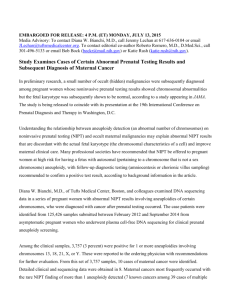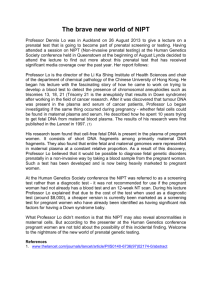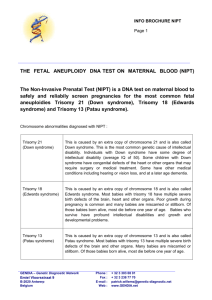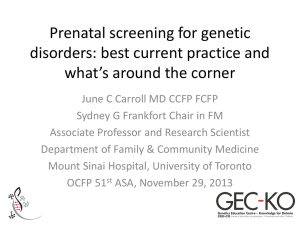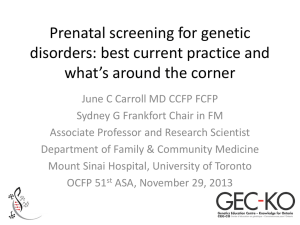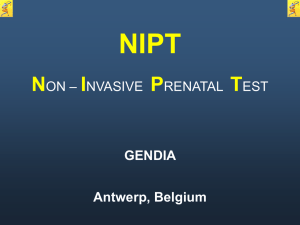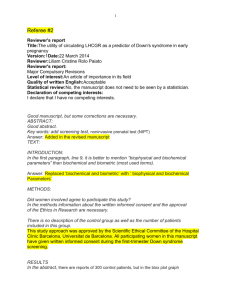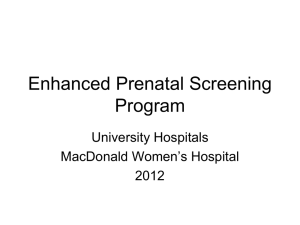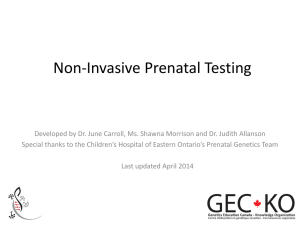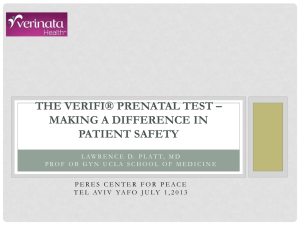GPCE NIPT - Dr Shian Miller
advertisement
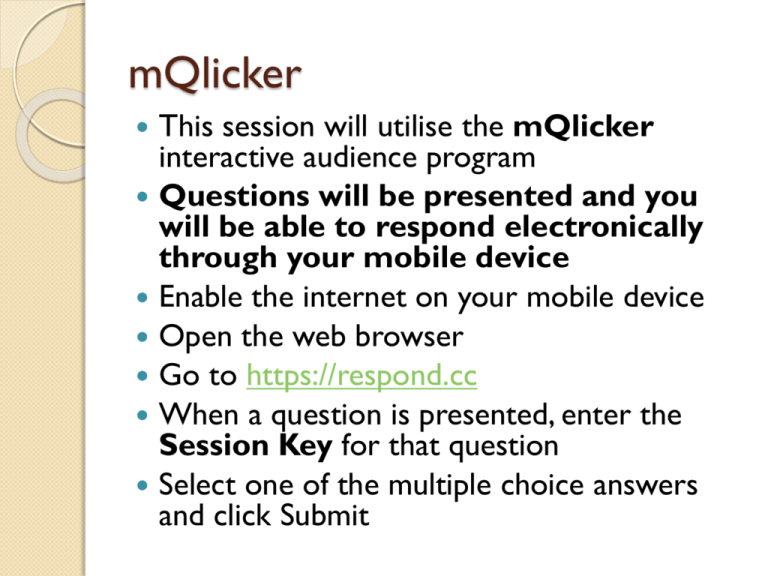
mQlicker This session will utilise the mQlicker interactive audience program Questions will be presented and you will be able to respond electronically through your mobile device Enable the internet on your mobile device Open the web browser Go to https://respond.cc When a question is presented, enter the Session Key for that question Select one of the multiple choice answers and click Submit Non-Invasive Prenatal Testing: Increasing Detection of Down’s Syndrome to >99% Dr Shian Miller Obstetrician & Gynaecologist BSc (Hon), MBBS, FRANZCOG Disclaimer This session is not funded by a pharmaceutical nor medical device company Dr Shian Miller is an independent obstetrician and gynaecologist practicing general obstetrics and general gynaecology Dr Shian Miller currently has no involvement with any of the companies offering NIPT and does not collect, market, nor perform NIPT – any promotion of NIPT is done only as a practising obstetrician mQlicker This session will utilise the mQlicker interactive audience program Questions will be presented and you will be able to respond electronically through your mobile device Enable the internet on your mobile device Open the web browser Go to https://respond.cc When a question is presented, enter the Session Key for that question Select one of the multiple choice answers and click Submit mQlicker check SESSION KEY: 47255 Q1- I am a: 1. GP 2. Specialist 3. Nurse or nurse practitioner 4. Student 5. Non-medical layperson 6. Other (mQlicker answers) mQlicker Question SESSION KEY: 27230 Q2 – My current knowledge about NIPT is: 1. What is it? 2. I’ve heard of it 3. I know a little bit about it 4. I have a good knowledge about NIPT 5. I’m an expert (mQlicker answers) mQlicker Question SESSION KEY: 5530 Q3 – The number of times I have recommended, counselled, or ordered NIPT for a patient before is: 1. Never 2. Once 3. A few times 4. More than 10 times 5. All the time (mQlicker answers) Prenatal screening Prenatal screening & diagnosis aims to detect conditions before a fetus is born Can be non-invasive: maternal serum screening, ultrasound Or can be invasive: amniocentesis, CVS, fetal blood sampling Genetic testing of fetuses previously required invasive techniques – now NonInvasive Prenatal Testing (NIPT) can indirectly sample fetal DNA from maternal blood Overview Biology of NIPT – cfDNA Clinical applications of NIPT Use of NIPT for aneuploidy screening Discordant results NIPT in practice Currently available NIPT options The future of NIPT Cell-free DNA in maternal blood In 1997, Lo et al published the discovery of circulating cell-free fetal DNA in the maternal serum Presence of fetal DNA in maternal plasma and serum.YM Dennis Lo et al. The Lancet 1997; 350: 485-87 Fragments of DNA are released from placental cells through apopotosis into the maternal circulation Generally, cell-free DNA (cfDNA) in maternal blood is 90% from maternal bone marrow and 10% from placenta Placental cfDNA is detectable before placental circulation is developed – present in useful amounts from 8-9 weeks gestation Placental cell-free DNA Increased levels with abnormal placentation – placenta accreta, preeclampsia – and Trisomy 21 (more apoptosis) Decreased levels in obese women – thought to be due to apoptosis of adipose tissue increasing maternal fraction Clearance of placental cfDNA As the DNA fragments are not contained within a cell, they are unstable and have a short half-life of 4-30 minutes Placental cfDNA is undetectable in maternal serum within hours of delivery Thus, placental cfDNA detected during a pregnancy is considered to be representative of the current fetus Non-Invasive Prenatal Test (NIPT) NIPT involves collecting maternal blood and analysing it for placental cfDNA DNA fragments need to be multiplied millions of times in a short period of time Although cfDNA discovered in 1997, not until the technology became commercially available in 2005, could NIPT be realised The technology was ‘Massively Parallel Sequencing’ or Next Generation Sequencing – complex molecular biology Overview of NIPT process Sequencing cfDNA The simplified explanation is: The cfDNA is multiplied millions of times (both maternal and placental/fetal) The relative quantity of each chromosome is compared to a reference genome Then look for over-representation of a chromosome Eg. Excess chromosome 21 compared to other chromosomes suggest Down’s syndrome Excess Chromosome Not just chromosomes Using targeted sequencing, can also detect single gene mutations and microdeletions Clinical applications of NIPT Aneuploidy, typically Trisomy 21 (Down’s), Trisomy 18 (Edward’s), Trisomy 13 (Patau’s) and XY abnormalities Main reason for screening these trisomies is that, unlike other trisomies, these often progress to a live birth Gender determination, particularly for history of X-linked disorders Single gene disorders – cystic fibrosis, myotonic dystrophy Fetal RhD typing to direct management of pregnant women with Anti-D antibodies mQlicker Question SESSION KEY: 27902 Q4 – I think the vast potential of NIPT is: 1. Scary 2. Troubling 3. Neither concerning nor exciting 4. Promising 5. Going to open up many terrific opportunities (mQlicker answer) Use of NIPT in aneuploidy screening Since introduction in Australia in late 2012, more than 2000 women have used NIPT for aneuploidy screening Generally targeted to high-risk women but appears to be as effective in a low-risk population Currently, the most appropriate implementation strategy for NIPT in the Australian context is still to be determined Current prenatal aneuploidy screening In Australia, high uptake of combined first trimester screening (CFTS) Involves a blood test for bHCG and PAPP-A Also an ultrasound scan at 11-13+6 weeks Apart from aneuploidy, screening also beneficial for: ◦ ◦ ◦ ◦ ◦ Correct dating of pregnancy Anatomy assessment Increased NT is a marker for other abnormalities Biochemistry also predicts pre-eclampsia, IUGR Information about multiple pregnancies NIPT compared to CFTS Sensitivity Specificity False positive False negative PPV CFTS 90% 95% 3-5% NIPT >99% >99% <0.5% 10% <1% 4% 45% NIPT advantages High negative predictive value – reduces need for invasive testing High detection rate of >99% for Trisomy 21 and >90% for Trisomy 18 & 13 Only a maternal blood test No risk to the fetus Gender determination Available from 10 weeks gestation onwards – useful for those who have missed CFTS NIPT disadvantages Anatomical abnormalities not detected – cfDNA even with anencephaly Still considered a screening test – if a result is ‘positive’, still need invasive testing (CVS/amniocentesis) to confirm Does not target atypical chromosome abnormalities – account for 30% of abnormal karyotypes Some types of NIPT not suitable for twins Cost – no Medicare rebate Discordant results Low false positive rate of 0.2% Causes include: ◦ ◦ ◦ ◦ ◦ ◦ ◦ ◦ ◦ Placental mosaicism Co-twin demise Organ transplant eg kidney transplant; male donor Bone marrow transplant False negative 45XO – cryptic mosaic – fetus XO, placenta XX Maternal chromosomal abnormality Increasing maternal age – white cells can ‘lose an X’ and become ‘XO’ – somatic mosaicism Laboratory error Occult cancer – sheds chromosomes chaotically Multiple aneuploidy in occult cancer No result from NIPT Test failure rate <5% Obese women have a significantly reduced fetal fraction of cfDNA For a maternal weight of 160kg, 50% of samples will have fetal fraction <4% If sample taken too early in the pregnancy, may have false negative results for Y chromosome or Rhesus status NIPT for Twin pregnancies Currently there is limited experience with performance of NIPT for twins Results to date are promising Lower sensitivity for detecting aneuploidy Fetal fraction is not double that of a singleton but less than that – may affect test performance NIPT in practice NIPT can be performed from 10 weeks gestation Currently no controls or guidelines for use Women have taken it up in an ad hoc way As it involves only a maternal blood test and poses no risk to the fetus, very attractive to mothers Previously prohibitively expensive but now easily obtained at under $500 (becoming comparable to CFTS ~$300) Ease of access may mean implications of test results may not be considered adequately Risk of commercialisation – marketing direct to consumer Models for the use of NIPT in aneuploidy screening CFTS – if high risk >1:300, offer NIPT or invasive testing CFTS – tiered management (contingent) 1. 2. ◦ ◦ ◦ ◦ Very low risk <1:1000 – no further testing Low risk 1:1000 to 1:300 – offered no further testing or NIPT High risk >1:300 – offered NIPT or invasive testing Very high risk >1:10 – invasive testing Other models for using NIPT 3. 4. 5. Routine NIPT at 10 weeks gestation then ultrasound at 12 weeks (for dating, anatomy assessment) – if no result, recommend CFTS Routine NIPT, ultrasound, and biochemistry NIPT only for high risk women: maternal age >35, previous history of aneuploidy, known parental balanced translocation mQlicker Question SESSION KEY: 81114 Q5 – The model that appeals to me is: 1. CFTS then if high-risk, NIPT or invasive testing 2. CFTS with contingent screening 3. Routine NIPT then USS 4. Routine NIPT then USS and biochemistry 5. NIPT only for high-risk women; CFTS for low-risk women (mQlicker answers) Ethical considerations with NIPT Gender determination used for gender selection Use in paternity testing Discovery of previously unknown maternal genetic disorder, eg Turner mosaicism Screening non-specifically for genetic alterations may lead to findings of uncertain significance Termination decision based on NIPT result only (trend in the USA) Current availability of NIPT in Australia Previously required shipping samples overseas in a Streck tube (contains a preservative that allows DNA to remain stable even in ambient temperatures) Now, laboratories available in Australia Turnaround time for overseas labs 7-10 days – Australian labs 3-4 days Available at major pathology labs, obstetric ultrasound places, fertility specialists and private obstetricians Different labs & technology but very similar NPV and sensitivity and specificity GPs will be the front-line Increasing public awareness of NIPT Consultations regarding NIPT are likely to be initiated by pregnant women themselves GPs will be the first point of contact GPs should be able to provide counseling and guidance to inform appropriate decision making Likely, GPs will order NIPT for patients before contact with obstetrician/hospital mQlicker Question SESSION KEY: 63987 Q6 – Now I feel confident counseling a patient about NIPT: 1. Strongly disagree 2. Disagree 3. Neutral 4. Agree 5. Strongly agree (mQlicker answers) mQlicker Question SESSION KEY: 83696 Q7 – Now, I think the vast potential of NIPT is: 1. Scary 2. Troubling 3. Neither concerning nor exciting 4. Promising 5. Going to open up many terrific opportunities (mQlicker answers) CASE ONE 19yo G1P0 at 10 weeks gestation Planned pregnancy; excited No significant history CASE ONE – mQlicker Question SESSION KEY: 65943 What aneuploidy screening do you recommend? 1. None required 2. Offer CFTS 3. Offer NIPT with anatomy USS 4. Offer invasive testing (CVS, amnio) (mQlicker answers) CASE TWO 40yo G1P0 at 10 weeks gestation Planned pregnancy; excited Fit and well, no significant history CASE TWO – mQlicker Question SESSION KEY: 32294 What aneuploidy screening do you recommend? 1. None required 2. Offer CFTS 3. Offer NIPT with anatomy USS 4. Offer invasive testing (CVS, amnio) (mQlicker answers) CASE THREE 30yo G3P2 at 10 weeks gestation First child had Down’s syndrome Parental karyotypes normal No other history of note CASE THREE – mQlicker Question SESSION KEY: 18373 What aneuploidy screening do you recommend? 1. None required 2. Offer CFTS 3. Offer NIPT with anatomy USS 4. Offer invasive testing (CVS, amnio) (mQlicker answers) CASE FOUR 28yo G1P0 at 10 weeks gestation Known maternal balanced translocation of chromosome 21 No other history of note CASE FOUR – mQlicker Question SESSION KEY: 91700 What aneuploidy screening do you recommend? 1. None required 2. Offer CFTS 3. Offer NIPT with anatomy USS 4. Offer invasive testing (CVS, amnio) (mQlicker answers) The future of NIPT Still some doubt about the place of NIPT in prenatal screening in Australia The USA has taken it up enthusiastically – uptake of CFTS has always been poorer Prices will continue to fall Professional organisations are under pressure to establish guidelines for use NIPT is very likely to take a central role in the future of Australian prenatal screening mQlicker Question SESSION KEY: 74249 Q8 – My feelings about NIPT are: 1. I worry Gattaca (eugenics) is going to become the reality 2. I think NIPT probably won’t live up to the hype 3. My feelings about NIPT are neutral 4. I think NIPT is going to be useful 5. I agree with Shian – NIPT is going to be the future! (mQlicker answers)
